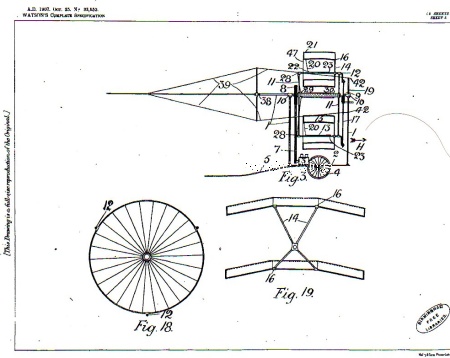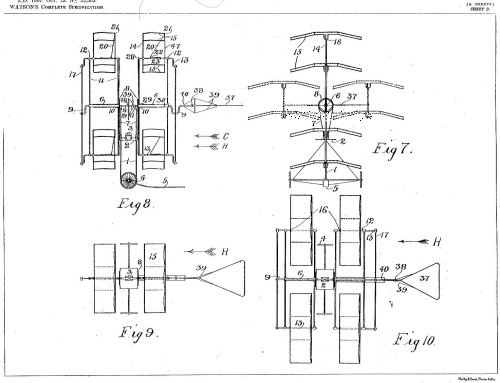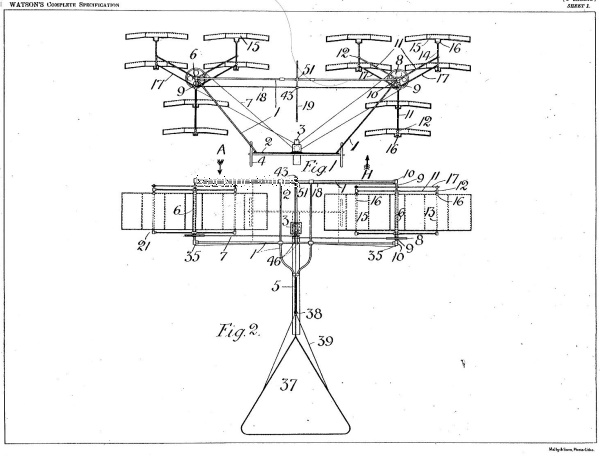On 25 October 1907 Preston Watson applied for a patent that, "...relates to flying machines, the object being to raise and propel a machine through the air without aerostats." Accepted in its entirety nearly a year later, Patent No.23,553 of 1907, titled Watson's flying machines comprises eight pages of descriptions of an indigenous rotary-wing means of creating lift to be applied to flying machines and five illustrations to which the description pages are keyed to.
These show different configurations of aircraft using the same rotary aerofoil devices that were presumably meant to propel the machine through the air and provide lift simultaneously. These devices, which resemble the sheathing mechanisms of a combine harvester are described in the patent as thus;
"When birds fly the arms carrying the wing surfaces have a vibratory [flapping?] motion, while the means adopted in this invention consists in giving the wings, while not themselves rotating, a motion of circular translation in a plane at right angles to the direction of flight and causing them to feather to the air stream while rising, but preventing their feathering while being driven downwards."
The principal means of propulsion by the devices proposed in the patent was via the action of the wing surfaces mounted on the whirling arms.
"When the arms carrying the wings are driven upwards the planes of the wings feather round a horizontal axis at right angles to the direction of flight... When the arms bearing the wings are driven downwards, the planes of the wings are kept from feathering round this axis by means of stops or bars."
"Because the planes of the wings do not turn about an axis parallel to the direction of flight in their rise and fall, the air streams alternately strike their upper and under sides respectively, and therefore these stops or bars, while allowing the wings to feather as they rise, prevent the wings feathering as they are driven downwards..."

Sheet five of five pages of illustrations (sheet one is at the head of this page) shows a side view of one of the patent's rotary winged devices (fig. 3). Fig. 18 shows a primary rotating support for the arms that drive the whirling wings at #8 on the side illustration, with #12 being bearings. Fig. 19 shows an alternative means of strengthening in the bracing of the whirling wing surfaces from front on. The Patent Office
Described as "whirling arms" in the text of the patent, the structures carrying the wing surfaces were, "...duplicated, and one of each revolves on either side far enough apart to prevent downward air from striking the engine, and both [whirling arms] are [located] somewhat above it. The two are exactly opposite to each other relatively to the direction of flight..." These two whirling arms were intended to be contra-rotating, and were driven by,"...an engine driving two shafts rotating in opposite directions... which would be of very light moving parts", although no specific type of engine is mentioned.
Directional control was to be achieved by moving ballast either side to side or fore and aft, although, "this can be affected by tilting the tail upwards or downwards." Watson also intended that his machine be capable of stationary flight, the hover being affected by perpetual rotation of its wing surfaces, made... "...possible by giving all the power to lift as against the power always required for propulsion of an aeroplane."
Watson's detailed but slightly baffling specification also stipulates the superiority of incorporating his ideas in a flying machine over a conventional aeroplane, claiming that an aeroplane is less efficient than one of Watson's machines because of, "the saving of power by the rotation of the wings...", and because of, "the small wing surface necessary compared to the aeroplane because the size of the wing is immaterial in this machine, smaller wings only requiring a higher rate of revolution, no power being lost in the latter case."
"The ordinary aeroplane with upward tilted anterior [leading] edge impelled forward by a screw drives the air partially forwards and the normal pressure of the aeroplane is partially backwards relative to the direction of flight... The air driven forwards by the aeroplane itself is the cause of lost power, because this impelling of the air in a forward direction is quite unnecessary in flight."
Watson's alternative to this 'phenomenon' is, "flight...accomplished by means of wings driven downwards successively with their anterior edges tilted downwards so as to give an upward and forward pressure, the air is driven downwards and backwards and in as much as upward and forward pressure are both wanted in flight, ...no unnecessary power is used."
While it is obvious that Watson gave his specification a great deal of thought, it is evident that he did not carry out any practical experiments that could have validated his statements prior to submitting the patent. There is no formulaic description of how the motion of his whirling arms achieved lift, therefore, how he came up with his aerodynamic theories is a mystery. The remarkable aspect of Watson's specification is how far off the mark his thinking was regarding what is actually required for the production of lift and for successful controllable flight.
Just three months after his 1907 patent was approved on 25 October 1908, he applied for a patent for his rocking wing idea, the configuration of his aircraft in the diagram accompanying the complete specification was entirely conventional in layout, rocking wing suspended above the main wing notwithstanding. Based on this about-face in his patented concepts, it can be seen how much his ideas had changed from the time he originally applied for his first patent to when it was approved just under twelve months later.

More views of the patent flying machines showing different configurations of the rotating wing surfaces. The direction of the arrows show the direction of flight. Displaying remarkable clarity of description in the text of the patent, thus illustrating Prston Watson's conviction for his work, his 1907 Patent remained well hidden in 1953 whilst his younger brother attempted to justify his claim that Preston flew in 1903. The Patent Office
In 1953 while preparing his case that was to supposedly prove Preston flew a powered aircraft before the Wrights, James Watson must have overlooked how flawed his brother's 1907 specification was, or was he simply not aware of its existence? Had Preston built a successful flying machine in 1903, why would he, four years later produce a work as fantastical as his 1907 patent?
There are some who believe that it was one of the machines illustrated in the patent that Watson flew in 1903, but there is no evidence that suggests Watson ever began construction of such a device. Why would he? By late 1908 when the patent had been accepted in its entirety he had already formulated his rocking wing design. That some of the eyewitnesses claim they saw such a device in flight in 1903 shows to what degree of exaggeration these people were keen to go to in order to justify James Watson's claim.
Under the heading The advantages of a machine constructed in accordance with my invention, in his 1907 patent Watson lists the following, "the saving on this account of power by not having to turn the plane of wings about an axis parallel to the line of flight." Based on this statement, it seems that even at that time Watson considered the methods of achieving a successful turn in flight in use on flying machines inefficient. Watson later proclaims that, "I thus provide a heavier-than-air machine, which will accomplish aerial flight, [and] will have more stable equilibrium both transversely and longitudinally than heretofore."
Regardless of what ideas he had however, there was no means whatsoever that his whirling wing aircraft described in Patent No.23,553 of 1907 were going to solve the problems that he foresaw in achieving successful flight.
Now, read about Watson's next patent on “rocking wings” here
